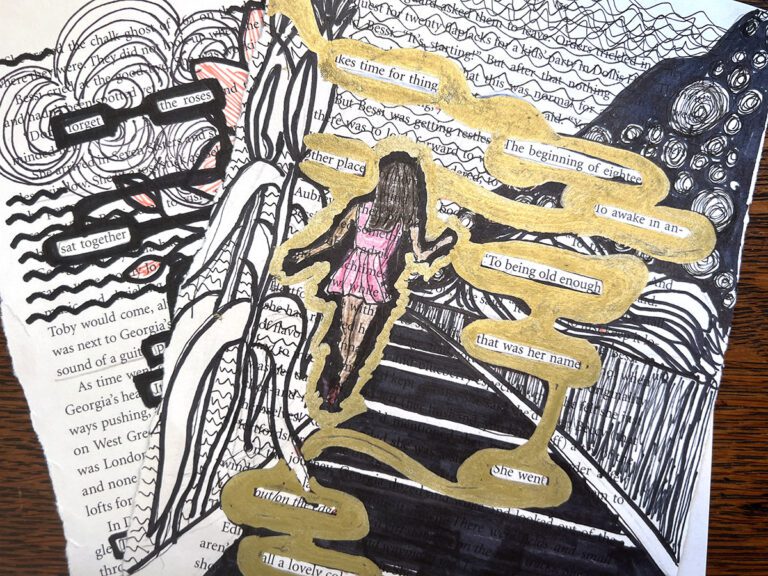So much has happened in our country since you last met with your students in your school. When you return in the fall, whether online or in-person, how can you use art with your students to acknowledge the world around them?
More specifically, the Black Lives Matter movement was highly visible in response to the tragic death of George Floyd. Images flooded social media and the news. Students may have even experienced it through their own real-time involvement and/or household conversations. One major player in the collective effort was the artwork developed by artists and communities across the country. Art pieces of all mediums, including signs and murals, expressed many messages in a highly effective and engaging way.
Art has been used as a way to respond and document events and happenings since the dawn of time. Creating art can be a meaningful experience, but so can viewing artwork from others. Reviewing and interacting with images can help students “develop ideas and understandings of society, culture, and history through their interactions with and analysis of art” (Anchor Standard 11, Enduring Understanding, National Core Arts Standards). Using art from the Black Lives Matter movement in your classroom is a relevant opportunity to address this standard.
The following artists are directly working and responding to the Black Lives Matter movement:
Please note: Students’ individual beliefs, experiences, and values about the Black Lives Matter movement may vary, as well as your own. Some students might have also experienced trauma related to connecting issues. As a result, be intentional about your lesson planning, and think about how you can lay the foundation for a positive learning experience. This could include protocols to discuss race and other issues. “Let’s Talk” by Teaching Tolerance can be a helpful resource on strategies for difficult discussions in your classroom.
1. Adrian Brandon

Brandon’s series, “stolen,” features Black people “who were robbed of their lives at the hands of the police.” The subjects range in age and are drawn in pencil and then finished with markers. What is most noticeable to the viewer is the partial renderings that illustrate the subject’s life. Brandon colors for one minute per year the subject was alive. For example, his portrait of seven-year-old Aiyana Stanley-Jones was only colored for seven minutes. His intention is clear and deliberate when he says, “I want the viewer to see how much empty space is left in these lives, stories that will never be told, space that can never be filled.” Each individual piece is impactful in their own right, but viewing the whole series is truly compelling and prompts thought and reflection.
2. Danielle Coke

Known on Instagram as @ohhappydani, Coke’s designs and illustrations are minimal and effective. So effective that she has nearly half a million followers on social media. One of her most recognizable designs features Ahmaud Arbery and the quote by Senator Kamala Harris, “Exercising while Black should not be a death sentence.” Much of Cokee’s work focuses on her perspective as a black Christian woman in America, and she’s currently focused on uplifting the voice of anti-racism. Her work reflects a positive mood and ranges in topic and subject matter, including messages for White people on their journey of racial understanding and awareness.
3. Street Artists

In many cases, the most powerful impact has been the collective responses by artists across major cities. Boarded up windows became canvases for artists to unite and express powerful messages. Groups like Paint The City in Chicago are organizing to support artists and the effort. Similarly, “Black Lives Matter” has been painted on the roads in cities like Birmingham, Alabama, and Washington, D.C. People everywhere are seeing the impact art can have on a movement when artists bring the work to the people. The imagery shouts ideas and messages in a way that can’t be ignored by anyone passing by.
4. Nikkolas Smith

A former theme park designer, Smith is now a highly accomplished concept artist. His work has been featured in countless publications like TIME magazine and The New York Post and shared on social media by the likes of Michelle Obama, Jamie Foxx, and Mark Ruffalo. Smith’s style and mood vary, but he mostly stays committed to centering on Black culture, including iconic moments and figures. Many of his images provoke reactions and emotions for reasons obvious in the subject matter. Others, however, prompt reflection and thought. The range of ideas in Smith’s work can help cast a wide net to engage all students in discussion.
Art has played a significant role in all that has unfolded in the past few months. Showing students how art can be involved in a social and political movement is a relevant and authentic learning experience. Students can discuss in the classroom or personally reflect and respond as a way to process their own thoughts and understandings. This is also an opportunity for you to further your instructional strategies on having difficult discussions in the classroom. The National Core Arts Standards can also help support your lesson planning at each grade level. Ultimately, this movement is highlighting the real power of art, and that’s a lesson your students need to hear.
What other artists or artwork should we share with students?
How can we help students use artwork to process their current experience?
Magazine articles and podcasts are opinions of professional education contributors and do not necessarily represent the position of the Art of Education University (AOEU) or its academic offerings. Contributors use terms in the way they are most often talked about in the scope of their educational experiences.





